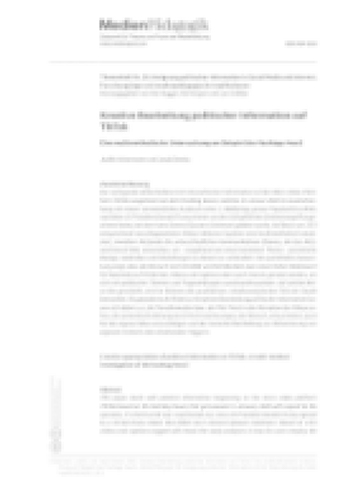Abstract
The use and regulation of mobile media devices of children and adolescents in refugee families is largely unexplored. Our qualitative approach utilizes in-depth guided interviews with parents and children in Arabic speaking refugee families in Germany. All interviewed families have resided in Germany from one to four years. The sample consists of both couples and single parents, while most children are in their final year of kindergarten, in primary school, or secondary school. The study explores the selection and usage of mobile media devices and content in their social context, such as the use of social media platforms and apps at home and for school. Our research highlights changes in mobile media usage after the interviewees’ arrival in Germany due to the different socio-cultural environment and a changed media agency. The amount of change greatly depends on the age of the children, for example, the younger they were when arriving in Germany, the less likely they are to use mobile media to stay in touch with their former friends. Additionally, most children and adolescents tend to consume German media content more often than Arabic content. In the rare cases they do consume Arabic media content, it is in the presence of their parents, who state that they do so to bring their children closer to their roots.
References
Amt für Statistik. 2017. «Einwohnerinnen Und Einwohner mit Migrationshintergrund am Ort der Hauptwohnung in Berlin am 31.12.2014 nach LOR 1 und ausgewählten Herkunftsgebieten». Potsdam, Berlin-Brandenburg.
Arnold, Sina, Stephan Oliver Görland, and Samira Abba. 2017. «Digitalisierung und selbstorganisierte migrantische Logistik». Solidarität im Wandel?: 286–96. Berlin. https://www.bim.hu-berlin.de/media/Forschungsbericht_ BIM_Fluchtcluster_23032017.pdf.
Baacke, Dieter. 1997. Medienpädagogik. Grundlagen der Medienkommunikation. Band I. Tübingen
Bulger, Monica, and Patrick Davison. 2018. «The Promises, Challenges, and Futures of Media Literacy». Journal of Media Literacy Education, 10 (1), 1–21.
Díaz Andrade, Antonio, and Bill Doolin. 2016. «Information and Communication Technology and the Social Inclusion of Refugees». MIS Quarterly 40 (2): 405–16. https://doi.org/10.25300/MISQ/2016/40.2.06.
Diminescu, Dana. 2008. «The Connected Migrant: An Epistemological Manifesto». Social Science Information 47 (4): 565–79.
Fiedler, Anke. 2016. «Information to Go: Kommunikation im Prozess der Migration am beispiel Syrischer und Irakischer Flüchtlinge auf Ihrem Weg Nach Deutschland». Global Media Journal 6 (1).
Friedrichs-Liesenkötter, Henrike, and Caroline Schmitt. 2017. «Digitale Medien als Mediatoren von Agency: Empirische Einblicke in Medienpraktiken junger Geflüchteter und die (medien-) pädagogische Arbeit». Medienimpulse 3/2017.
Gajjala, Radhika. 2004. Cyberselves: Feminist Ethnographies of South Asian Women. Walnut Creek, CA: AltaMira Press.
Hasebrink, Uwe, and Andreas Hepp. 2017. «How to Research Cross-Media Practices? Investigating Media Repertoires and Media Ensembles.» Convergence: The International Journal of Research into New Media Technologies 23 (4): 362–77. https://doi.org/10.1177/1354856517700384.
Hasebrink, Uwe, and Jutta Popp. 2006. «Media Repertoires as a Result of Selective Media Use. A Conceptual Approach to the Analysis of Patterns of Exposure». Communications 31 (3): 369–87.
Hedge, Radha S. (ed.). 2011. Circuits of Visibility: Gender and Transnational Media Cultures. New York: NYU Press.
Hopkins, Nicolas S., and Saad Eddin Ibrahim. (ed.). 2006. Arab Society: Class, Gender, Power & Development. Cairo: The American University in Cairo Press.
Horst, Heather A., and Erin B Taylor. 2014. «The Role of Mobile Phones in the Mediation of Border Crossings: A Study of Haiti and Dominican Republic». The Australian Journal of Anthropology. 25(2). 155-170.
Hurrelmann, Klaus, and Ullrich Bauer. 2018. Socialisation During the Life Course. London/New York: Routledge.
Jandura, Olaf, Manuel Wendelin, Marian Adolf, and Jeffrey Wimmer. (ed.). 2017. Zwischen Integration und Diversifikation. Medien und gesellschaftlicher Zusammenhalt im digitalen Zeitalter. Wiesbaden: Springer VS.
Kutscher, Nadia, and Lisa-Marie Kreß. 2018. «Digitale Medien bei Geflüchteten». In Handbuch Soziale Arbeit mit geflüchteten Kindern und Familien, by L. Hartwig, G. Mennen, and C. Schrapper, 739–44. Weinheim/Basel: Beltz Juventa.
Livingstone, Sonia. (ed.). 2011. Media Literacy: Ambitions, Policies and Measures. Brussels, Belgium. ISBN 9782960115727.
Mayring, Philipp. 2000. «Qualitative Content Analysis». Forum Qualitative Sozialforschung / Forum: Qualitative Social Research 1 (2), [28 Paragraphs].
Molnár, Kay Magdalena. 2008. Am Anfang war das Bild. Medienerziehung im Kindergarten am Beispiel der Aktiven Fotoarbeit. Stuttgart: Ibidem Verlag.
Parham, Angel Adams. 2004. «Diaspora, Community and Communication: Internet Use in Transnational Haiti». Global Networks 4: 199–217.
Paus-Hasebrink, Ingrid, and Uwe Hasebrink. 2018. «Mit Medienkompetenz gegen Falschinformation?» Aviso 66: 6.
Richter, Carola, Marlene Kunst, and Martin Emmer. 2016. «Flucht 2.0: Zur Forschung mit/über Flüchtlinge und ihre Mediennutzung.» Global Media Journal - German Edition 6(2016) (1).
Rinnawi, Khalil. 2012. «‘Instant Nationalism’ and the ‘Cyber Mufti’: The Arab Diaspora in Europe and the Transnational Media». Journal of Ethnic and Migration Studies 38 (9): 1451–1467.
Valkenburg, Patti M., Marina Krcmar, Allerd L. Peeters, and Nies M. Marseille. 1999. «Developing a scale to assess three styles of television mediation: Instructive mediation, restrictive mediation, and social coviewing.» Journal of Broadcasting and Electronic Media 43 (1): 52–67.
Witteborn, Saskia. 2015. «Becoming (Im)perceptible: Forced Migrants and Virtual Practice». Journal of Refugee Studies. 28 (3): 350–367.
Wilding, Raelene. 2006. «‘‘Virtual’’ Intimacies? Families Communicating Across Transnational Contexts». Global Networks 6: 125–142.
Zaman, Bieke, Marije Nouwen, Jeroen Vanattenhoven, Evelien de Ferrerre, and Jan Van Looy. 2016. «A Qualitative Inquiry into the Contextualized Parental Mediation Practices of Young Children’s Digital Media Use at Home». Journal of Broadcasting & Electronic Media 60 (1): 1–22.

